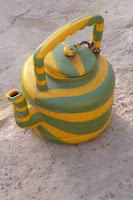It’s still quiet when I open my door this morning. I see Aida with a large bucket of water on her head to water the garden. Buba is sitting still half asleep in a corner. Nanchou, his youngest brother is playing. Whenever I see him I notice this necklace with stones on his neck. The other day I asked about the stones. ‘Juju’, was the answer. Juju? It’s an amulet from the maribu. The juju helps if you have an injury or pain and protects small children. When I look closer I notice more stones: in the hair of Bintu, on the arm of my landlord. And how about that yellow stone in my own bag? A gift from my friend, to protect me on my travels.
The juju is part of ancestor religion of the
different tribes here in the Gambia. You can see more of this, if you look
closely and recognize it.
Believe in
the neighborhood
Two of my Arkade colleagues invite students to look closely in
their neighborhood for aspects of religion. It’s part of this great new digital
class material for grade 7 and 8 in primary schools in the Netherlands: Geloof in de Buurt (Believe in the neighborhood).
It emphasize on Critical Citizenship and Religion. I think the material
inspires youngsters to dialogue with each other about religion and philosophy
of life. Watch the promo film to get an idea about the material and to hear the enthusiasm of lecturer Monique
Leygraaf and the principal of the Bavinck school in Hilversum about Geloof in de Buurt!
Aspects of
religious Gambia
What else
is there to be seen about religion in my neighborhood? Let’s take a morning
going from my compound to Gambia College in Brikama.
Starting
very early in the morning - if the power is running – I hear a call for prayer.
At the compound I see colorful watering cans for
the washing before praying. Greetings between me and the sales man in the
little shop where I buy my bread: ‘As salaam alaikum. Alaikum salaam.’ An Islamic aspect
when I hear my Gambian name while I’m walking towards the high way: ‘Hello Hajja Camara, how is the morning?’Hajja refers to a woman who has been on pilgrimage to Mecca. Stickers
with the name of Allah and prayers beads in front of the bush-taxi. Sitting next to a woman with a small cross
around her neck. A mosque near the road in Busumbala, the mosque near the road in Farrato. A sign along
the road of one of the Methodist schools. A phone call to Lamin (revering to
prophet Mohammed) - before the phone connects I hear 'bismi-llāhi r-raḥmāni r-raḥīm' on the other line. And although
it’s a bit further then the College, I know the big church is next to
the big mosque in Brikama center.
So many
aspects of Islam. And some Christian aspects here in this Combo area. Pretty
obvious while 95% of the Gambian population is Muslim. And the other 5 % is mostly
Christian.
What about aspects of religion in your neighborhood?




